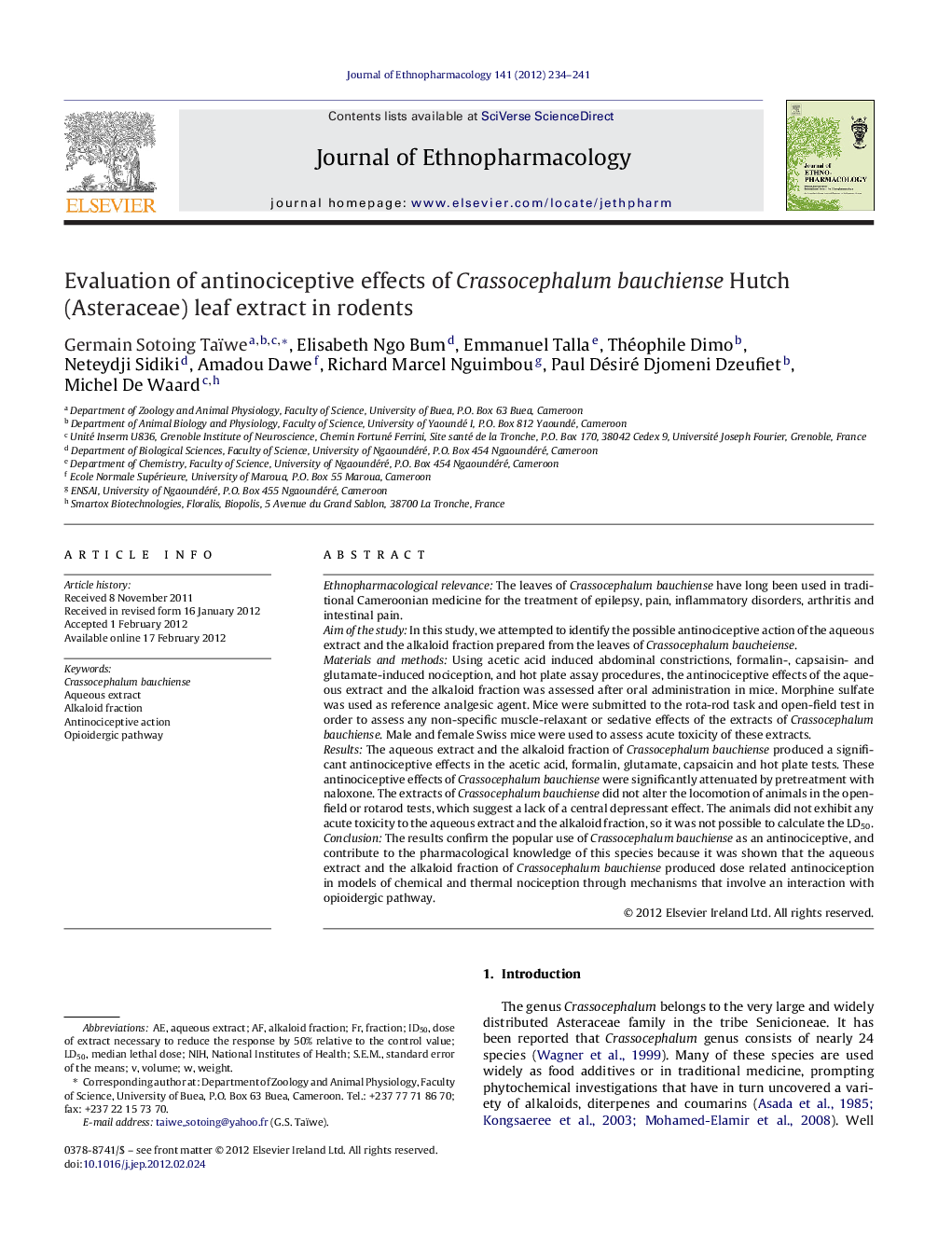| کد مقاله | کد نشریه | سال انتشار | مقاله انگلیسی | نسخه تمام متن |
|---|---|---|---|---|
| 5838217 | 1123977 | 2012 | 8 صفحه PDF | دانلود رایگان |
عنوان انگلیسی مقاله ISI
Evaluation of antinociceptive effects of Crassocephalum bauchiense Hutch (Asteraceae) leaf extract in rodents
دانلود مقاله + سفارش ترجمه
دانلود مقاله ISI انگلیسی
رایگان برای ایرانیان
کلمات کلیدی
موضوعات مرتبط
علوم پزشکی و سلامت
داروسازی، سم شناسی و علوم دارویی
داروشناسی
پیش نمایش صفحه اول مقاله

چکیده انگلیسی
Ethnopharmacological relevanceThe leaves of Crassocephalum bauchiense have long been used in traditional Cameroonian medicine for the treatment of epilepsy, pain, inflammatory disorders, arthritis and intestinal pain.Aim of the studyIn this study, we attempted to identify the possible antinociceptive action of the aqueous extract and the alkaloid fraction prepared from the leaves of Crassocephalum baucheiense.Materials and methodsUsing acetic acid induced abdominal constrictions, formalin-, capsaisin- and glutamate-induced nociception, and hot plate assay procedures, the antinociceptive effects of the aqueous extract and the alkaloid fraction was assessed after oral administration in mice. Morphine sulfate was used as reference analgesic agent. Mice were submitted to the rota-rod task and open-field test in order to assess any non-specific muscle-relaxant or sedative effects of the extracts of Crassocephalum bauchiense. Male and female Swiss mice were used to assess acute toxicity of these extracts.ResultsThe aqueous extract and the alkaloid fraction of Crassocephalum bauchiense produced a significant antinociceptive effects in the acetic acid, formalin, glutamate, capsaicin and hot plate tests. These antinociceptive effects of Crassocephalum bauchiense were significantly attenuated by pretreatment with naloxone. The extracts of Crassocephalum bauchiense did not alter the locomotion of animals in the open-field or rotarod tests, which suggest a lack of a central depressant effect. The animals did not exhibit any acute toxicity to the aqueous extract and the alkaloid fraction, so it was not possible to calculate the LD50.ConclusionThe results confirm the popular use of Crassocephalum bauchiense as an antinociceptive, and contribute to the pharmacological knowledge of this species because it was shown that the aqueous extract and the alkaloid fraction of Crassocephalum bauchiense produced dose related antinociception in models of chemical and thermal nociception through mechanisms that involve an interaction with opioidergic pathway.
ناشر
Database: Elsevier - ScienceDirect (ساینس دایرکت)
Journal: Journal of Ethnopharmacology - Volume 141, Issue 1, 7 May 2012, Pages 234-241
Journal: Journal of Ethnopharmacology - Volume 141, Issue 1, 7 May 2012, Pages 234-241
نویسندگان
Germain Sotoing Taïwe, Elisabeth Ngo Bum, Emmanuel Talla, Théophile Dimo, Neteydji Sidiki, Amadou Dawe, Richard Marcel Nguimbou, Paul Désiré Djomeni Dzeufiet, Michel De Waard,